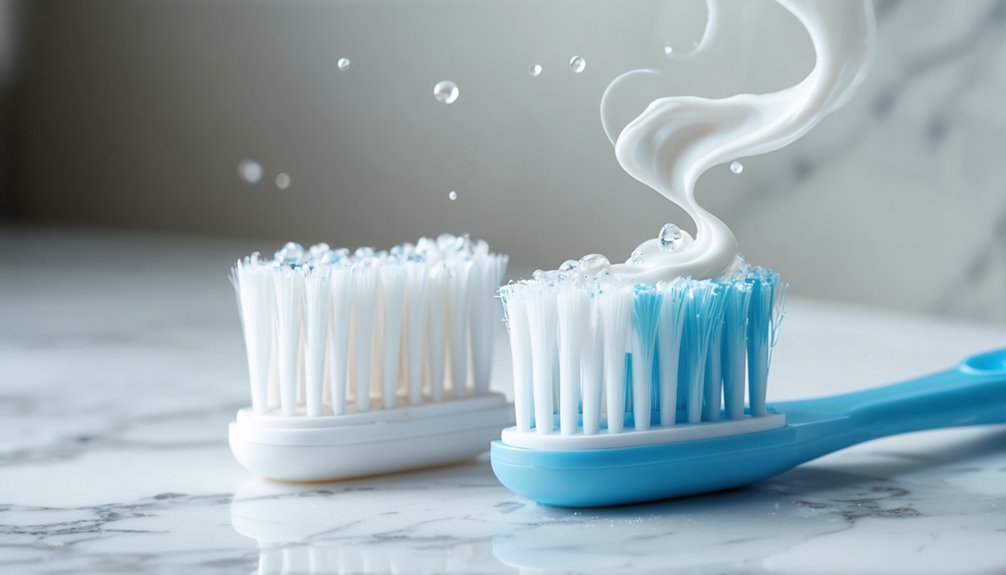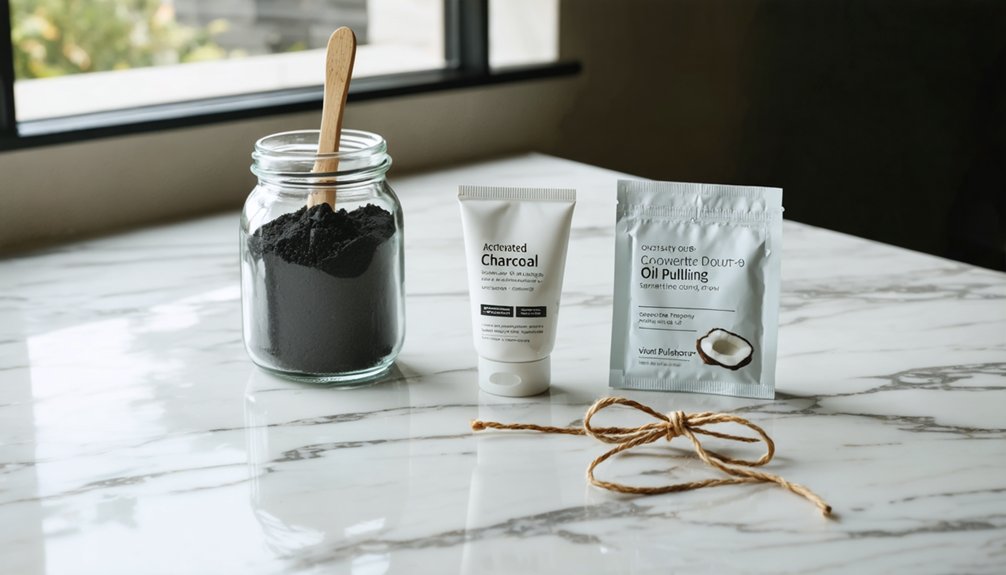Whitening toothpaste formulated for sensitive teeth offers you a safe way to brighten your smile while protecting vulnerable tooth surfaces. These specialized products contain gentle whitening agents combined with desensitizing ingredients like potassium nitrate and nano-hydroxyapatite, which help block nerve responses and strengthen enamel. You’ll get gradual stain removal without the discomfort of harsh bleaching agents. Understanding the science behind these specialized formulations can help you make the best choice for your dental needs.
Key Takeaways
- Specialized whitening toothpaste contains desensitizing agents like potassium nitrate that block nerve responses while gently removing stains.
- Low-abrasion formulations protect enamel integrity during whitening, reducing sensitivity while effectively removing surface discoloration.
- These toothpastes combine gentle whitening agents with remineralizing ingredients to strengthen teeth and prevent future sensitivity issues.
- Gradual whitening through specialized toothpaste is gentler than intensive bleaching treatments, making it ideal for sensitive teeth.
- Regular use provides continuous protection while achieving natural whitening results, rather than harsh, temporary bleaching effects.
Understanding Tooth Sensitivity After Whitening
While teeth whitening can effectively brighten your smile, it often leads to temporary tooth sensitivity due to the effects of bleaching agents on dental structures.
The whitening compounds, primarily hydrogen peroxide and carbamide peroxide, temporarily increase your tooth enamel’s porosity, exposing the underlying dentinal tubules that connect to nerve endings. Anti-sensitivity toothpaste helps minimize discomfort during the whitening process.
You’ll typically experience sensitivity when your teeth encounter temperature extremes, sweet or acidic foods, or even just exposure to air. This occurs because the whitening process causes temporary nerve exposure through microscopic channels in your teeth.
The severity varies among individuals, with about half experiencing mild discomfort, while fewer report moderate to severe sensitivity. Those using products with higher bleaching concentrations may experience increased sensitivity levels. Most cases resolve within 1-2 weeks as your enamel naturally remineralizes and returns to its normal protective state.
The Science Behind Sensitive Teeth and Whitening
To better understand why teeth become sensitive during whitening, let’s examine the complex interplay between bleaching agents and dental structures.
Your tooth anatomy plays a significant role in sensitivity triggers during whitening treatments. When hydrogen peroxide or carbamide peroxide penetrates your enamel, it affects the organic matrix – particularly in dentin, where 20% consists of collagen proteins. Professional-grade whiteners contain higher bleach concentrations that can intensify this effect.
Understanding tooth anatomy is crucial, as whitening agents interact with your enamel and dentin’s organic structure, potentially triggering sensitivity.
These agents create microscopic pathways that temporarily expose nerve endings, leading to sensitivity. If you have existing enamel wear or gum recession, you’re more susceptible to discomfort as the bleaching compounds can more easily reach the sensitive inner layers. Patients who brush too aggressively often develop worn enamel that increases whitening sensitivity.
The concentration and exposure time of whitening agents directly influence your sensitivity risk, which is why it’s vital to choose formulations that balance effective whitening with gentle treatment of your dental tissues.
Key Benefits of Specialized Whitening Toothpaste
You’ll find specialized whitening toothpaste offers effective stain removal while using low-abrasion formulas that protect your sensitive teeth.
Your enamel remains safeguarded through gentle whitening agents combined with remineralizing ingredients like fluoride and nano-hydroxyapatite.
These formulations not only brighten your smile but also build lasting protection against future sensitivity through consistent use.
Alternating between regular and whitening formulas can help minimize tooth discomfort while maintaining results.
Products like Crest 3D White Whitening Therapy provide 3D White smile results while addressing multiple oral care needs simultaneously.
Gentle Yet Effective Whitening
Because sensitive teeth require special care, specialized whitening toothpaste combines gentle stain removal with enamel protection to achieve noticeable results without triggering discomfort.
Unlike aggressive whitening products, these formulations use gentle abrasives specifically calibrated to polish away surface stains while preserving your enamel integrity. Products like Sensodyne Gentle Whitening deliver reliable results when used twice daily. With 4.7 star ratings from thousands of users, these specialized formulas have proven their effectiveness.
You’ll notice gradual whitening that works by restoring your teeth’s natural shade rather than bleaching beyond it. The formula’s mild polishing components avoid harsh scrubbing that could irritate sensitive areas, while simultaneously strengthening your enamel against future staining.
Through consistent use, you’ll achieve visible stain reduction without compromising your oral health. This balanced approach guarantees you can maintain a brighter smile while protecting your teeth’s natural defensive barriers, making it ideal for daily care of sensitive teeth.
Protection Against Future Sensitivity
While traditional whitening products can increase tooth sensitivity, specialized whitening toothpaste offers extensive protection against future discomfort through multiple defensive mechanisms.
You’ll benefit from desensitizing agents like potassium nitrate and strontium chloride that create protective barriers, blocking nerve responses to temperature changes and other stimuli.
For lasting future protection, these toothpastes contain nano-hydroxyapatite and remineralizing compounds that strengthen your enamel, filling microscopic defects and preventing dentin exposure. Good oral hygiene combined with regular dental cleanings will maximize the protective benefits of these specialized toothpastes.
The low-abrasive formulation preserves enamel thickness while effectively managing sensitivity prevention. By blocking dentin tubules and reducing fluid movement that triggers nerve responses, you’ll experience fewer sensitivity episodes.
This all-encompassing approach guarantees your teeth stay comfortable while achieving desired whitening results, making it ideal for patients with recurring sensitivity concerns. Studies show that using toothpaste with low RDA scores ensures gentler cleaning without compromising effectiveness.
Essential Ingredients That Make a Difference
The essential ingredients in whitening toothpaste for sensitive teeth work together to deliver both stain removal and comfort for compromised enamel.
When you’re selecting a sensitive whitening toothpaste, look for formulations that combine potassium nitrate benefits with fluoride synergy for superior results.
- Potassium nitrate (5%) desensitizes nerve endings, providing immediate relief from temperature and pressure sensitivity.
- Fluoride strengthens enamel and promotes remineralization while working synergistically with whitening agents.
- Baking soda offers gentle stain removal while neutralizing harmful acids that can trigger sensitivity.
- Hydrated silica provides controlled whitening without aggressive abrasion that could worsen sensitivity.
- Alternative ingredients like nano-hydroxyapatite and xylitol support both whitening and sensitivity relief while offering natural options.
Safe Whitening Methods for Sensitive Teeth
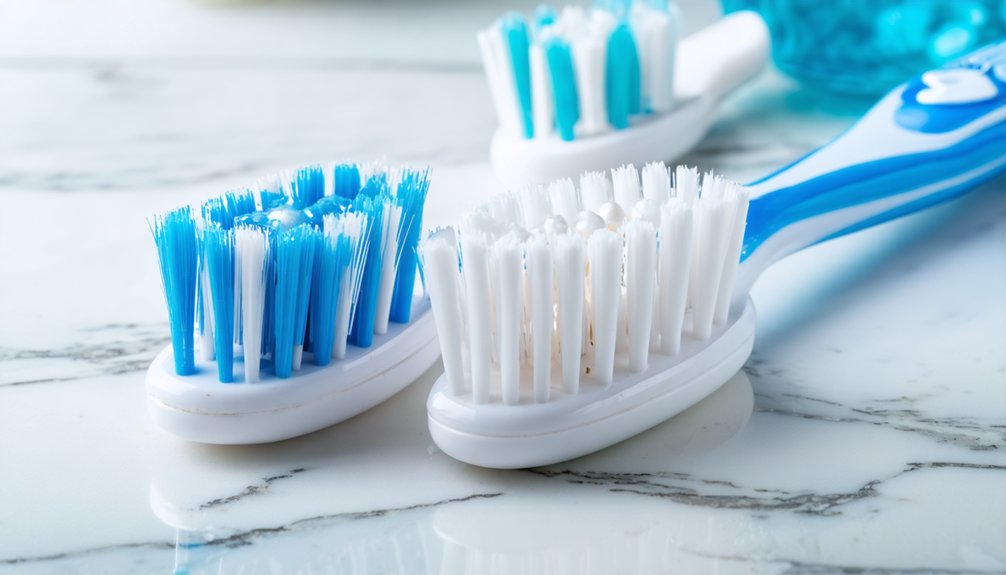
People with sensitive teeth can safely achieve a brighter smile through scientifically-proven whitening methods that prioritize gentle treatment approaches.
Professional treatments like Zoom Whitening use LED-activated gels with controlled peroxide concentrations, while custom-fitted trays offer personalized at-home solutions that minimize discomfort.
Advanced dental whitening technology combines precise peroxide control and custom-fitted solutions to ensure both effectiveness and comfort for sensitive teeth.
You’ll find that low-concentration peroxide products, enhanced with natural ingredients and desensitizing agents like potassium nitrate and fluoride, effectively whiten teeth without triggering pain.
User testimonials consistently support the success of these gentler options.
It’s essential to avoid abrasive whitening methods, such as charcoal or harsh baking soda treatments, which can damage enamel and worsen sensitivity.
Instead, opt for specially formulated sensitive teeth whitening products that combine proven stain-fighting power with protective ingredients to maintain your enamel’s integrity.
Managing Sensitivity During the Whitening Process
You’ll experience less discomfort during teeth whitening by adopting a gradual approach rather than attempting dramatic results quickly.
Your teeth need time to adjust to whitening agents, so spacing out treatments allows the enamel to recover between sessions.
Using protective ingredients like potassium nitrate and fluoride in your whitening products will help block sensitivity signals to nerve endings while strengthening your tooth enamel throughout the process.
Gradual Whitening Reduces Pain
When sensitive teeth make whitening seem challenging, gradual approaches offer a more comfortable path to a brighter smile. You’ll experience enhanced whitening comfort through lower-concentration products that deliver gradual results while protecting your teeth’s sensitivity threshold.
- Choose products with 5.25% peroxide concentration for gentler whitening
- Use desensitizing agents like fluoride or potassium nitrate during treatment
- Monitor your progress to adjust treatment intensity as needed
- Take breaks between sessions to allow your enamel to recover
- Consider professional guidance for a customized whitening plan
Protective Ingredients Fight Sensitivity
Special protective ingredients in sensitive whitening toothpastes work together to shield vulnerable teeth while lifting stains.
Potassium nitrate acts as your primary defender, calming tooth nerves and reducing pain within two weeks of regular use. You’ll find it at roughly 5% concentration in leading sensitive whitening formulas.
While potassium nitrate tackles nerve sensitivity, fluoride provides essential enamel strengthening and protection against decay.
The formulas also incorporate gentle, low-abrasion cleaning agents that are 40% softer than regular whitening pastes.
Additional soothing ingredients like glycerin and natural peppermint oils enhance comfort, while baking soda helps neutralize acids that can trigger sensitivity.
These protective elements work synergistically to deliver effective whitening while maintaining your teeth’s comfort and structural integrity.
Comparing Different Whitening Options
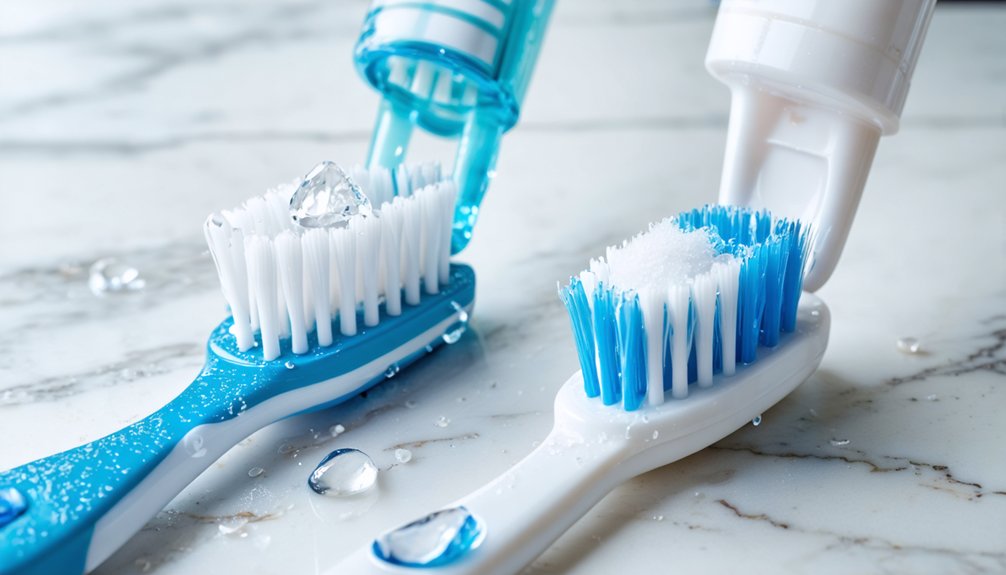
Several whitening options exist for those with sensitive teeth, each offering distinct benefits and drawbacks.
When evaluating whitening methods, you’ll need to weigh how different approaches may act as sensitivity triggers. Traditional bleaching treatments using peroxide compounds often cause more discomfort than gentler alternatives.
- Whitening toothpaste uses mild abrasives and desensitizing agents for gradual stain removal.
- Professional bleaching delivers dramatic results but risks increased sensitivity.
- At-home whitening strips and gels contain strong bleaching agents that may cause temporary pain.
- Specialized sensitive teeth formulas incorporate potassium nitrate to block nerve pathways.
- Toothpaste with nano-hydroxyapatite helps strengthen enamel while whitening.
For daily maintenance that balances brightening with comfort, whitening toothpaste designed for sensitive teeth typically offers the most sustainable approach to achieving a brighter smile.
Professional Recommendations and Best Practices
To protect your sensitive teeth while whitening, you’ll need to follow key safety guidelines recommended by dental experts, including using ADA-approved products with desensitizing ingredients and maintaining proper brushing technique.
When selecting a whitening toothpaste, prioritize formulas containing potassium nitrate or nano-hydroxyapatite, while avoiding highly abrasive agents that could damage vulnerable enamel.
You should monitor your progress and any sensitivity changes over time, adjusting your routine as needed and consulting your dentist if persistent sensitivity occurs.
Dental Expert Safety Guidelines
Professional dental experts have established thorough safety guidelines for using whitening toothpaste on sensitive teeth, emphasizing the importance of proper product selection and application methods.
To protect your enamel and manage tooth sensitivity effectively, follow these expert-recommended safety protocols:
- Start with fluoride-containing toothpaste two weeks before whitening to strengthen your enamel.
- Choose products with lower peroxide concentrations specifically designed for sensitive teeth.
- Monitor your teeth’s response and stop treatment if extreme sensitivity occurs.
- Use gentle brushing techniques with soft-bristled toothbrushes and lukewarm water.
- Schedule regular dental checkups to assess your tooth health and adjust whitening protocols.
Always consult your dentist before beginning any whitening regimen, especially if you have existing sensitivity, gum disease, or tooth decay.
They’ll help customize a safe approach that balances your whitening goals with enamel protection.
Recommended Product Selection Criteria
When choosing a whitening toothpaste for sensitive teeth, carefully evaluating key selection criteria can make the difference between a successful treatment and potential discomfort.
Focus on product effectiveness by selecting toothpaste with lower RDA scores and proven desensitizing agents like potassium nitrate or stannous fluoride. You’ll want to verify ingredient transparency by checking for the ADA seal of approval and avoiding harsh chemicals or high-acid formulations.
Professional dental teams, including Tribeca Smiles and Kirkland experts, emphasize proper brushing technique and consistent twice-daily use.
They recommend monitoring your sensitivity levels and adjusting your routine accordingly. If you’re experiencing persistent sensitivity, don’t hesitate to seek personalized recommendations from your dentist, who can evaluate your specific needs and suggest the most suitable whitening toothpaste for your situation.
Monitoring Progress Over Time
Successful whitening treatment for sensitive teeth requires systematic monitoring and careful progress tracking to achieve the best results while minimizing discomfort.
You’ll need to document your whitening journey using objective tools and consistent symptom documentation to guarantee safety and effectiveness.
- Use a dental shade guide to track color changes accurately during your whitening process.
- Take regular photos to visually document improvements and identify when you’ve reached ideal results.
- Keep a sensitivity diary to monitor any discomfort levels and adjust treatment accordingly.
- Schedule regular breaks between applications to allow your teeth time to recover.
- Maintain periodic dental check-ups for professional assessment of your progress and enamel health.
Remember to discontinue treatment if you experience significant sensitivity or notice no further improvements in whitening results.
Long-Term Effects and Preventive Measures
Understanding the long-term effects of whitening toothpaste on sensitive teeth is essential for maintaining ideal oral health. Regular use of abrasive toothpaste ingredients can gradually wear down your enamel, potentially leading to increased sensitivity and vulnerability to decay.
Whitening toothpaste may damage sensitive teeth over time, as harsh abrasives wear away protective enamel and increase vulnerability to problems.
You’ll want to be particularly mindful of signs like heightened sensitivity to hot and cold, or teeth appearing more translucent.
To protect your teeth while whitening, focus on enamel restoration through preventive measures. Limit your use of whitening products, and opt for gentle formulations specifically designed for sensitive teeth.
You should consult your dentist for personalized guidance on safe whitening methods. Consider incorporating desensitizing treatments before starting any whitening regimen, and monitor your sensitivity levels throughout the process to adjust your approach as needed.
Choosing the Right Product for Your Needs
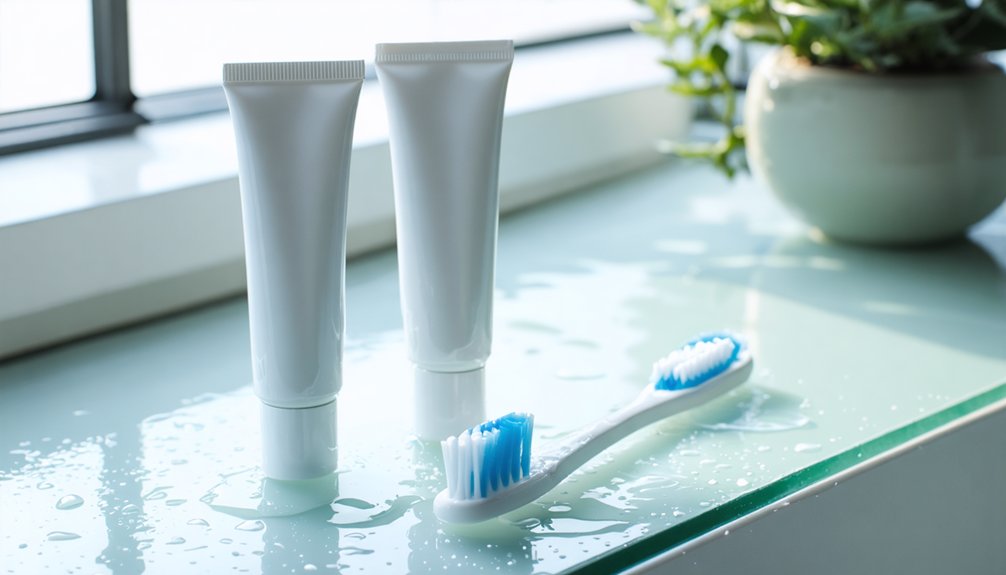
Selecting the right whitening toothpaste for sensitive teeth requires careful consideration of your specific dental needs and sensitivity levels.
Product comparisons reveal that leading brands like Sensodyne, Crest, and Colgate offer specialized formulas combining gentle whitening with proven ingredient efficacy for sensitivity relief.
When choosing your ideal product, focus on these essential factors:
- Look for desensitizing agents like potassium nitrate or stannous fluoride
- Verify the presence of mild abrasives for safe stain removal
- Check for the ADA Seal of Acceptance
- Avoid products containing sodium lauryl sulfate (SLS)
- Consider the concentration of whitening agents like hydrogen peroxide
You’ll achieve the best results by matching product features to your sensitivity level while maintaining realistic expectations about gradual whitening progress.
Consult your dental professional if you experience persistent sensitivity.
Frequently Asked Questions
Can I Use Whitening Toothpaste While Pregnant or Breastfeeding?
While you can use ADA-approved whitening toothpaste ingredients during pregnancy and breastfeeding, it’s best to consult your healthcare provider first. Many dental professionals recommend postponing whitening until after pregnancy dental care.
How Long Should I Wait After Dental Work to Use Whitening Toothpaste?
You’ll need to consult your dentist for specific post dental care timing, as sensitivity risks vary. Generally, wait until healing’s complete and any tooth sensitivity subsides before starting whitening toothpaste.
Will Whitening Toothpaste Remove Stains From Dental Crowns or Veneers?
No, whitening toothpaste won’t change your crowns or veneers’ color. While it can help with stain removal on natural teeth, dental aesthetics of restorations remain unchanged as they’re made from non-responsive materials.
Can Children Safely Use Whitening Toothpaste for Sensitive Teeth?
Like walking on thin ice, you shouldn’t let children use whitening toothpaste until age 12-13. For child dental health, stick to fluoride toothpaste and explore safe whitening options with your dentist.
Does Whitening Toothpaste Interact With Medications That Cause Tooth Staining?
You’ll find whitening toothpaste primarily targets surface stains from medications, but won’t greatly interact chemically with tooth-staining medications. Consult your dentist about medication effects before starting any whitening regimen.
References
- https://www.sensodyne.com/en-gb/oral-health-tips/whitening-sensitive-teeth/management-oral/
- https://www.colgate.com/en-us/oral-health/teeth-whitening/whitening-toothpaste-101-the-basics-of-daily-whitening
- https://www.tribecasmiles.com/top-whitening-toothpastes-for-sensitive-teeth-2025
- https://www.tolleydental.com/tolley-blog/is-it-safe-to-use-whitening-toothpaste-everyday/
- https://www.goodrx.com/conditions/dental-care/sensitive-teeth-after-whitening
- https://7northdental.com/blog/whitening-toothpaste-and-sensitive-teeth/
- https://www.colgate.com/en-us/products/toothpaste/sv-whitening
- https://www.soladentalspa.com/blog/options-for-sensitive-teeth-whitening
- https://tooth-doctor.com/severe-tooth-sensitivity-after-teeth-whitening/
- https://harrisburgsmilesdental.com/why-does-teeth-whitening-cause-sensitivity-understanding-the-basics/
